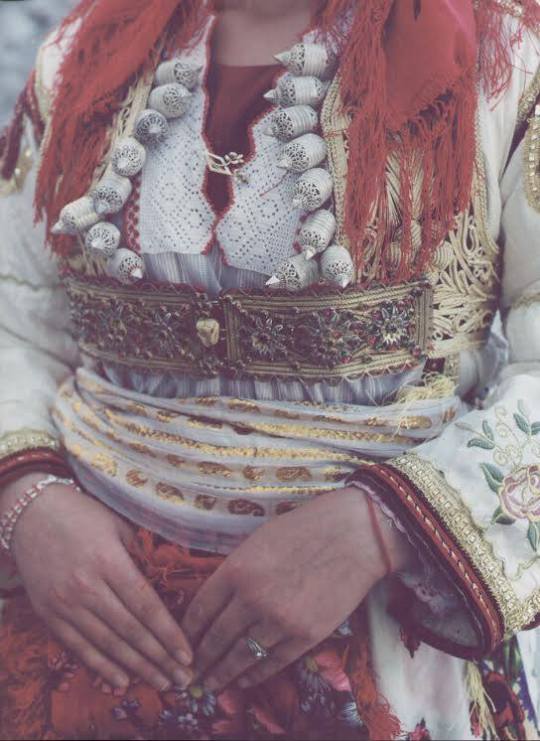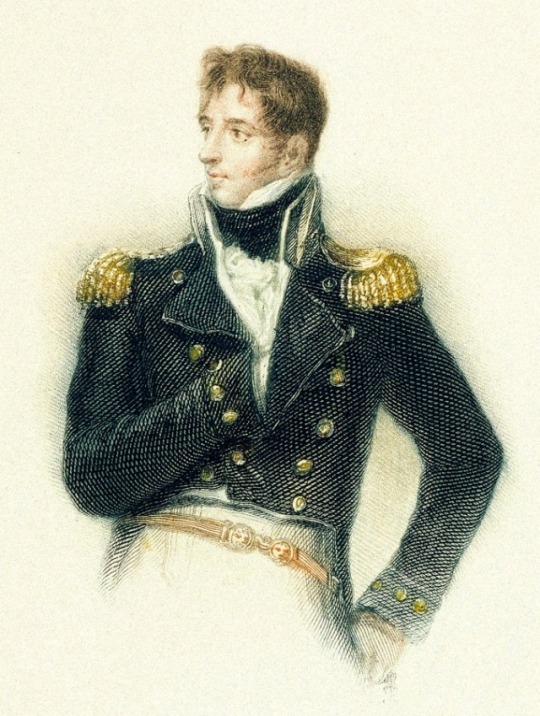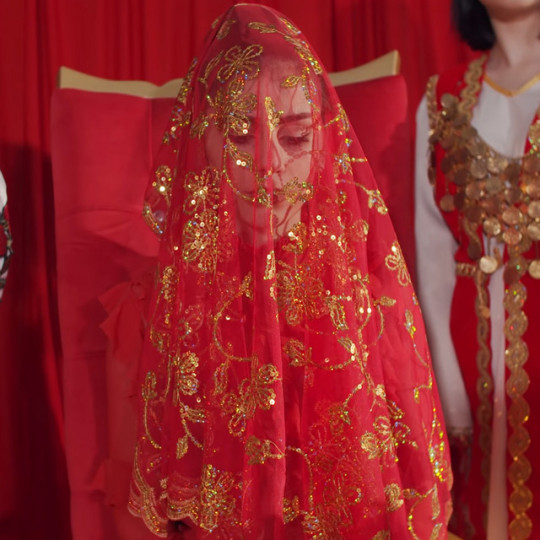#albanian costume
Explore tagged Tumblr posts
Text

Lord Byron In Albanian Dress
Artist: Thomas Phillips (British, 1770–1845)
Genre: Portrait
Date: 1813
Medium: Oil on Canvas
Collection: Government Art Collection, London, England
George Gordon Byron (1788–1824), 6th Baron Byron, Poet
This portrait of Lord Byron by Thomas Phillips depicts the renowned poet and society figure dressed in traditional Albanian costume. He wears an oriental-style, red velvet jacket and headdress, with a velvet cloak draped across his left arm. Byron bought the costume in the region of Epirus (part of modern Greece and Albania) in 1809, while on a Grand Tour across southern Europe with his great friend, the politician John Cam Hobhouse (1786–1869). Byron sat for this painting in 1813, at the age of 25, and evidently had some influence over its appearance. He was particularly sensitive to full-length representations of himself as he had suffered from a lame foot since childhood and had a noticeable limp. He also asked Phillips to repaint his nose in a more flattering fashion.
In the portrait, the translucent paleness of his skin contrasts with the dark velvet of his costume, inspiring Sir Walter Scott to liken the portrait to a beautiful alabaster lamp, lit from within. The portrait was exhibited to great acclaim at the Royal Academy in 1814. It was later bought by Lady Judith Noel, Byron’s mother-in-law, and hung at Kirkby Hall, her residence in Kirkby Mallory, Leicestershire.
#portrait#lord byron#albanian costume#thomas phillips#british painter#european#academician#turban#george gordon byron#poet#landscape#sword#oil on canvas#government art collection#19th century painting
19 notes
·
View notes
Text

Lord Byron in costume.
4 notes
·
View notes
Text












AeternaNova Northern Macedonian ethnographic project
"AeternaNova" (in Latin "aeterna"- ancient and "nova"-new) is an exhibition of photographs, folk costumes, and an ethnographic film, curated by Filip Petkovski Ph.D., UNESCO-certified heritage expert. It aims to represent the cultural heritage of Macedonians, Albanians, Turks, Roma, and Vlachs living in North Macedonia, and to feature recorded personal narratives of the models on the photos who are leaders in their professions (actors, musicians, athletes, public figures), about their views and experiences with diversity and inclusion.
The project incorporates new media, ethnography, and visual anthropology to contextualise the topic, while each photograph serves as a visual narrative aimed to illustrate the dynamic evolution of cultural identity in the region. We are led by the idea that cultural heritage must be reinterpreted and modernised to be largely disseminated, especially amongst the younger population, who might mystify and reject the topic of cultural heritage. The exhibition will take place at the Youth Cultural Centre in Skopje, while the results of the project will be published as a research paper in the journal "Macedonian Folklore" in which we will explore diversity, inclusion, and peaceful coexistence.
The project aims to emphasise the similarities in the cultures of all of the communities that live in North Macedonia and encourages the audience to engage in a process of mutual learning and enrichment of knowledge related to cultural heritage."
#folklore#ethnographic#slavic#folk costumes#slav#macedonian#macedonia#northern macedonia#vlach#albanian#turkic#yoruk#roma#macedonians#northern macedonians#balkan
411 notes
·
View notes
Photo

Detail of an Albanian traditional costume from Shestan.
#albanian#albania#region: shestan#shqiptar#Montenegro#balkan#balkans#costume#folk#folklore#traditional clothing
544 notes
·
View notes
Text

Muhammad Ali Pasha Viceroy of Egypt
Artist: Auguste Couder (French, 1789–1873)
Date: 1841
Medium: OIl on canvas
Collection: Museum of the History of France, Palace of Versailles, Paris, France
Muhammad Ali of Egypt
Muhammad Ali (4 March 1769 – 2 August 1849) was the Ottoman Albanian viceroy and governor who became the de facto ruler of Egypt from 1805 to 1848, widely considered the founder of modern Egypt. At the height of his rule, he controlled Egypt, Sudan, Hejaz, the Levant, Crete and parts of Greece.
He was a military commander in an Albanian Ottoman force sent to recover Egypt from French occupation under Napoleon. Following Napoleon's withdrawal, Muhammad Ali rose to power through a series of political maneuvers, and in 1805 he was named Wāli (governor) of Egypt and gained the rank of Pasha.
As Wāli, Ali attempted to modernize Egypt by instituting dramatic reforms in the military, economic and cultural spheres. He also initiated a violent purge of the Mamluks, consolidating his rule and permanently ending the Mamluk hold over Egypt.
Militarily, Ali recaptured the Arabian territories for the sultan, and conquered Sudan of his own accord. His attempt at suppressing the Greek rebellion failed decisively, however, following an intervention by the European powers at Navarino. In 1831, Ali waged war against the sultan, capturing Syria, crossing into Anatolia and directly threatening Constantinople, but the European powers forced him to retreat. After a failed Ottoman invasion of Syria in 1839, he launched another invasion of the Ottoman Empire in 1840; he defeated the Ottomans again and opened the way towards a capture of Constantinople. Faced with another European intervention, he accepted a brokered peace in 1842 and withdrew from the Levant; in return, he and his descendants were granted hereditary rule over Egypt and Sudan. His dynasty would rule Egypt for over a century, until the revolution of 1952 when King Farouk was overthrown by the Free Officers Movement led by Mohamed Naguib and Gamal Abdel Nasser, establishing the Republic of Egypt.
#portrait#painting#military leader#egyptian history#muhammad ali of egypt#viceroy of egypt#muhamad ali pasha#sitting#three quarter length#costume#turban#ottoman albanian#auguste couder#french painter#sword#french art#fine art#oil on canvas#19th century painting#artwork#european art#19th century art
29 notes
·
View notes
Photo

Albanian traditional clothing, Godolesh, Elbasan 1988. Photo: Nikolin Baba
#albanian#albania#balkan#balkans#traditional clothing#elbasan#godolesh#costume#folk#shqipëria#shqiptar#shqiperia
328 notes
·
View notes
Text

Guri Madhi (Albanian, 1921-1988) - Highlander, 1956
1 note
·
View note
Text

WIP Albanian Miku in a classic Dropoli costume (Dropulli in albanian)

Reference
73 notes
·
View notes
Note
I was very pleased with my English 1820s man. I made sure he had enrichment of a scholarly nature, to balance out the Romantic tendencies they have. He took to studying classical history and language, and I confess I was proud to have such an intelligent 19th century man. More recently he took an interest in current affairs but, as he is quite young, I assumed this was a sign of maturing. Then, just like that, he ran away! I went out searching and a neighbour informed me that he'd gone to Greece to fight against the Ottomans! I was horrified and went straight there, but I found him with a pack of Greek 1820s men and he adamantly refused to come home. What should I do? I worry that he will get hurt fighting, or that his constitution will not survive rough living in the Greek mountains. But he's having such a good time. He is learning the modern iteration of Greek (such a clever man), enjoys the local cuisine, and even wants to dress like his new friends. Is he in great danger if I let him stay, and how could I take him home without breaking his heart? (I don't want to risk any of those Greek 1820s men getting angry either, if I take their lucky mascot away.) Many thanks for your advice!
Romanticism and nationalism make for a very potent combination, as you have learned by now, and for many 19th century men of a certain social class and level of education, the attraction of the Classical world adds another layer of mythical folklore; not to mention the allure of pagan ceremony and skimpy neoclassical clothes.
For 1820s-1830s men, the Byronic appeal of exotic "Eastern" nations can be irresistible, and in general you will find a lot of national myth-making and interest in folk costumes.

Lord Byron in Albanian dress, 1813. This man is not Albanian!
You also have to be aware of your 19th century man's possibly very different ideas of national and imperial boundaries. He learns the polka in Bohemia, he wants to fight the Ottomans, he wants to fight in the Miguelite war—he might support Romantic German nationalism! It's not always the national and cultural understandings of the 21st century.
Being British is also not a guarantee of sensible behaviour. You might think that your British naval officer is going to rest on his laurels after the Napoleonic Wars, and the next thing you know, he's leading a fleet in the Chilean Independence movement!

Thomas Cochrane, naval officer for hire.
19th century men are not for the faint of heart. It can be challenging to balance their Romantic desires with a sensible course of action. Since your man has already spent so much time with his new Greek friends and has embraced their lifestyle, you could suggest that it's important that he document his experiences in a travel narrative that will also champion their cause.
As much as possible, you want to convince him that he's very valuable as a writer and/or visual artist giving voice to a cause—too valuable to foolishly risk his life or ruin his health abroad.
#is the 19th century man okay#asks#romanticism#nationalism#1830s#1820s#more problems caused by lord byron
131 notes
·
View notes
Text










Gizzeria, Calabria, Italy
Gizzeria is an Arbëreshë village situated on the Gulf of Lamezia Terme, on the Thyrrenian coast of Southern Italy's Calabria.
The center of town is 625 metres (2,051 ft) above sea level. Mount Mancuso is the town's highest point at 1,290 metres (4,230 ft) above sea level.
In ancient times this area was occupied by Italic and Greek settlements, which were later destroyed by the Saracens.
Gizzeria, was actually re-founded with the arrival of the Arbëreshë Albanian settlers fleeing from the Turks. These brought to Calabria, in addition to the language, their traditions, habits and customs which significantly changed the character of the native populations.
Today in Gizzeria the arbëreshë imprint remains only in a few words and in the traditional female costume, which has now almost disappeared.
The coast of Gizzeria has been rediscoveredas a spot for kiteboarding and windsurfing, thanks to the constant presence of winds. The place hosts in fact European kitesurfing championship.
There are several kitesurfing schools on the spot, which offer lessons, rentals, and recovery services.
Follow us on Instagram, @calabria_mediterranea
#gizzeria#calabria#italy#italia#south italy#southern italy#italian#mediterranean#mediterranean sea#landscape#italian landscape#traditional costume#folk costume#folklore#traditional clothing#europe#italian landscapes#landscapes#hills#mountains#sea#seascape#seaside#kitesurfing#arbereshe#albanians#kitesurf#Arbëreshë
31 notes
·
View notes
Text
Eurovision 2006 - Number 44 - Las Ketchup - "Bloody Mary"
youtube
Queco's back with another band of flamenco sisters. After 2005's disappointment with Son de Sol, Spain, TVE had decided to double-down on the same formula, but this time with a proven act who've already had a Europe wide mega-hit. Tomato-themed band Las Ketchup became one-hit wonders in 2002 with The Ketchup Song (Aserejé).
That was a song imitating The Sugarhill Gang's Rapper's Delight as sung by three sisters who don't know the words and have only heard it at maximum decibel level through the overloaded speakers of a downbeat club. That it got to number one in twenty European countries because of popularity in clubs is a testament to whole generation whose hearing is now so muddy, that they can no longer discern one song from another.
That was four years prior to 2006. In the intervening years, they appeared as backing singers for a song that finished in twentieth place as Sanremo in 2004. They've also been joined by their other sister, bringing the family group up to four members and necessitating the use of an extra office chair on stage. They're also upping the alcoholic content of their new song with Bloody Mary
This is considerably more laid back than Queco's previous song. Far less fraught and sultry and more about lying around a pool in the morning with a hangover, regretting the night before and demanding more alcohol. The staging matches this, although instead of sun-loungers, they've gone for office-chic for no discernible reason apart perhaps of cost. This is the era of Eurovision in which onstage chairs didn't have too much thought put into their selection.
There's no denying there's a degree of half-arsedness about this as well as huge sense of them having their tongues firmly planted in their cheeks. This might be TVE joining in with the trend to pastiche Eurovision and what it's turning into that in 2006 is becoming a trend all unto itself. I'm not entirely sure what the dancers are up to nor what their costuming choices suggest, but the overall effect of this does make me smile. Despite the song and presentation being resolutely absurd, there's a fair degree of subtly going on underneath. Las Ketchup know who they are and what's expected, and they deliver exactly that.
To no one's great surprise, it only got eighteen points and finished twenty-first. The two countries to vote for Las Ketchup were a big twelve points from Andorra and, more strangely, six points from the Albanian back-up jury.
You could say that 2005 and 2006 were Spain's dark times at Eurovision, but that's definitely not true. TVE were trying something with both of these internally selected entries - but Europe wasn't in the mood to listen.
Post 2006, the group have semi-stayed together, but that's largely to perform their one hit at events as surprise guest, for instance they turned up as the interval act for one of the semi-finals of Melodifestivalen in 2016. That may make them one of the only acts to have performed at both Sanremo and Melfest.
#esc 2006#esc#eurovision#eurovision song contest#Athens#Athens 2006#Youtube#Spain#TVE#Queco#Las Ketchup
4 notes
·
View notes
Text



Albanian folk costumes
74 notes
·
View notes
Photo

Albanian bride, henna night
288 notes
·
View notes
Text
If there was a Federation Vison Song Contest the Klingons would do everything exactly like the Albanians at the beginning, costumes, sound and stage and all, but for the entire song
21 notes
·
View notes

